ITO-Based Electrically Tunable Metasurface for Active Control of Light Transmission
Abstract
:1. Introduction
2. Materials and Methods
3. Results
4. Conclusions
Supplementary Materials
Author Contributions
Funding
Data Availability Statement
Conflicts of Interest
References
- Koshelev, K.; Tang, Y.T.; Li, K.F.; Choi, D.Y.; Li, G.X.; Kivshart, Y. Nonlinear Metasurfaces Governed by Bound States in the Continuum. ACS Photon. 2019, 6, 1639–1644. [Google Scholar] [CrossRef]
- Huang, L.L.; Chen, X.Z.; Mühlenbernd, H.; Li, G.X.; Bai, B.F.; Tan, Q.F.; Jin, G.F.; Zentgraf, T.; Zhang, S. Dispersionless Phase Discontinuities for Controlling Light Propagation. Nano Lett. 2012, 12, 5750–5755. [Google Scholar] [CrossRef]
- Huang, L.L.; Chen, X.Z.; Mühlenbernd, H.; Zhang, H.; Chen, S.M.; Bai, B.F.; Tan, Q.F.; Jin, G.F.; Cheah, K.W.; Qiu, C.W.; et al. Three-dimensional optical holography using a plasmonic metasurface. Nat. Commun. 2013, 4, 2808. [Google Scholar] [CrossRef]
- Deng, L.G.; Deng, J.; Guan, Z.Q.; Tao, J.; Chen, Y.; Yang, Y.; Zhang, D.X.; Tang, J.B.; Li, Z.Y.; Li, Z.L.; et al. Malus-metasurface-assisted polarization multiplexing. Light Sci. Appl. 2020, 9, 101. [Google Scholar] [CrossRef]
- Zheng, G.; Mühlenbernd, H.; Kenney, M.; Li, G.; Zentgraf, T.; Zhang, S. Metasurface holograms reaching 80% efficiency. Nat. Nanotechnol. 2015, 10, 308–312. [Google Scholar] [CrossRef]
- Tognazzi, A.; Rocco, D.; Gandolfi, M.; Locatelli, A.; Carletti, L.; De Angelis, C. High Quality Factor Silicon Membrane Metasurface for Intensity-Based Refractive Index Sensing. Optics 2021, 2, 193–199. [Google Scholar] [CrossRef]
- Du, K.; Barkaoui, H.; Zhang, X.D.; Jin, L.M.; Song, Q.H.; Xiao, S.M. Optical metasurfaces towards multifunctionality and tunability. Nanophotonics 2022, 11, 1761–1781. [Google Scholar] [CrossRef]
- Ou, X.; Zeng, T.; Zhang, Y.; Jiang, Y.; Gong, Z.; Fan, F.; Jia, H.; Duan, H.; Hu, Y. Tunable Polarization-Multiplexed Achromatic Dielectric Metalens. Nano Lett. 2022, 22, 10049–10056. [Google Scholar] [CrossRef]
- Wen, Y.; Zhang, Q.; He, Q.; Zhang, F.; Xiong, L.; Zhang, F.; Fu, G.; Xu, J.; Pu, M.; Luo, X. Shortening Focal Length of 100-mm Aperture Flat Lens Based on Improved Sagnac Interferometer and Bifacial Liquid Crystal. Adv. Opt. Mater. 2023, 11, 2300127. [Google Scholar] [CrossRef]
- Hu, Y.; Ou, X.; Zeng, T.; Lai, J.; Zhang, J.; Li, X.; Luo, X.; Li, L.; Fan, F.; Duan, H. Electrically Tunable Multifunctional Polarization-Dependent Metasurfaces Integrated with Liquid Crystals in the Visible Region. Nano Lett. 2021, 21, 4554–4562. [Google Scholar] [CrossRef]
- Sabri, R.; Forouzmand, A.; Mosallaei, H. Genetically optimized dual-wavelength all-dielectric metasurface based on double-layer epsilon-near-zero indium-tin-oxide films. J. Appl. Phys. 2020, 128, 223101. [Google Scholar] [CrossRef]
- Cai, Z.; Liu, Y. Near-Infrared Reflection Modulation Through Electrical Tuning of Hybrid Graphene Metasurfaces. Adv. Opt. Mater. 2022, 10, 2102135. [Google Scholar] [CrossRef]
- Tian, J.; Adamo, G.; Liu, H.; Wu, M.; Klein, M.; Deng, J.; Ang, N.S.S.; Paniagua-Dominguez, R.; Liu, H.; Kuznetsov, A.I.; et al. Phase-Change Perovskite Microlaser with Tunable Polarization Vortex. Adv. Mater. 2023, 35, e2207430. [Google Scholar] [CrossRef] [PubMed]
- Pianelli, A.; Caligiuri, V.; Dudek, M.; Kowerdziej, R.; Chodorow, U.; Sielezin, K.; De Luca, A.; Caputo, R.; Parka, J. Active control of dielectric singularities in indium-tin-oxides hyperbolic metamaterials. Sci. Rep. 2022, 12, 16961. [Google Scholar] [CrossRef]
- Dayal, G.; Ramakrishna, S.A. Broadband infrared metamaterial absorber with visible transparency using ITO as ground plane. Opt. Express 2014, 22, 15104–15110. [Google Scholar] [CrossRef] [PubMed]
- Huang, Y.W.; Lee, H.W.; Sokhoyan, R.; Pala, R.A.; Thyagarajan, K.; Han, S.; Tsai, D.P.; Atwater, H.A. Gate-Tunable Conducting Oxide Metasurfaces. Nano Lett. 2016, 16, 5319–5325. [Google Scholar] [CrossRef]
- Park, J.; Jeong, B.G.; Kim, S.I.; Lee, D.; Kim, J.; Shin, C.; Lee, C.B.; Otsuka, T.; Kyoung, J.; Kim, S.; et al. All-solid-state spatial light modulator with independent phase and amplitude control for three-dimensional LiDAR applications. Nat. Nanotechnol. 2021, 16, 69–76. [Google Scholar] [CrossRef]
- Forouzmand, A.; Salary, M.M.; Kafaie Shirmanesh, G.; Sokhoyan, R.; Atwater, H.A.; Mosallaei, H. Tunable all-dielectric metasurface for phase modulation of the reflected and transmitted light via permittivity tuning of indium tin oxide. Nanophotonics 2019, 8, 415–427. [Google Scholar] [CrossRef]
- Forouzmand, A.; Mosallaei, H. Tunable dual-band amplitude modulation with a double epsilon-near-zero metasurface. J Opt 2020, 22, 094001. [Google Scholar] [CrossRef]
- Palik, E.D. Handbook of Optical Constants of Solids; Academic press: Cambridge, MA, USA, 1998; Volume 3. [Google Scholar]
- Yi, F.; Shim, E.; Zhu, A.Y.; Zhu, H.; Reed, J.C.; Cubukcu, E. Voltage tuning of plasmonic absorbers by indium tin oxide. Appl. Phys. Lett. 2013, 102, 221102. [Google Scholar] [CrossRef]
- Klein, A.; Korber, C.; Wachau, A.; Sauberlich, F.; Gassenbauer, Y.; Harvey, S.P.; Proffit, D.E.; Mason, T.O. Transparent Conducting Oxides for Photovoltaics: Manipulation of Fermi Level, Work Function and Energy Band Alignment. Materials 2010, 3, 4892–4914. [Google Scholar] [CrossRef] [PubMed]
- Kafaie Shirmanesh, G.; Sokhoyan, R.; Pala, R.A.; Atwater, H.A. Dual-Gated Active Metasurface at 1550 nm with Wide (>300 degrees) Phase Tunability. Nano Lett. 2018, 18, 2957–2963. [Google Scholar] [CrossRef] [PubMed]
- Alaee, R.; Rockstuhl, C.; Fernandez-Corbaton, I. An electromagnetic multipole expansion beyond the long-wavelength approximation. Opt. Commun. 2018, 407, 17–21. [Google Scholar] [CrossRef]
- Savinov, V.; Fedotov, V.A.; Zheludev, N.I. Toroidal dipolar excitation and macroscopic electromagnetic properties of metamaterials. Phys. Rev. B 2014, 89, 205112. [Google Scholar] [CrossRef]
- Fan, S.; Suh, W.; Joannopoulos, J.D. Temporal coupled-mode theory for the Fano resonance in optical resonators. J. Opt. Soc. Am. A 2003, 20, 569–572. [Google Scholar] [CrossRef]
- Xie, Z.T.; Wu, J.Y.; Fu, H.Y.; Li, Q. Tunable Electro- and All-Optical Switch Based on Epsilon-Near-Zero Metasurface. IEEE Photon. J. 2020, 12, 1–10. [Google Scholar] [CrossRef]
- Shoaei, M.; Moravvej-Farshi, M.K.; Yousefi, L. All-optical switching of nonlinear hyperbolic metamaterials in visible and near-infrared regions. J. Opt. Soc. Am. B 2015, 32, 2358–2365. [Google Scholar] [CrossRef]
- Kim, S.J.; Brongersma, M.L. Active flat optics using a guided mode resonance. Opt. Lett. 2017, 42, 5–8. [Google Scholar] [CrossRef]
- Howes, A.; Wang, W.; Kravchenko, I.; Valentine, J. Dynamic transmission control based on all-dielectric Huygens metasurfaces. Optica 2018, 5, 787–792. [Google Scholar] [CrossRef]
- Zhang, J.; Yang, J.; Schell, M.; Anopchenko, A.; Tao, L.; Yu, Z.; Lee, H.W.H. Gate-tunable optical filter based on conducting oxide metasurface heterostructure. Opt. Lett. 2019, 44, 3653–3656. [Google Scholar] [CrossRef]
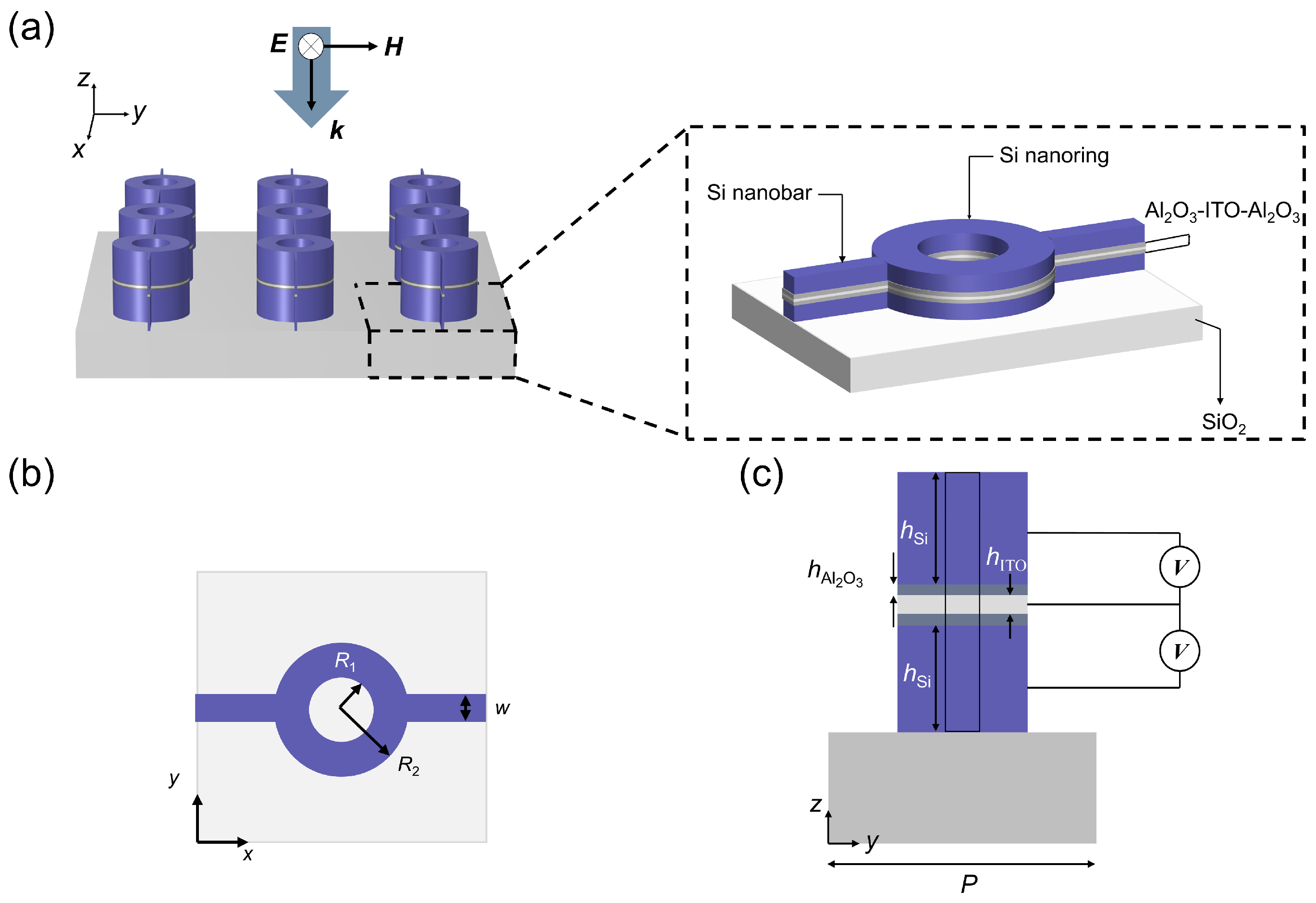
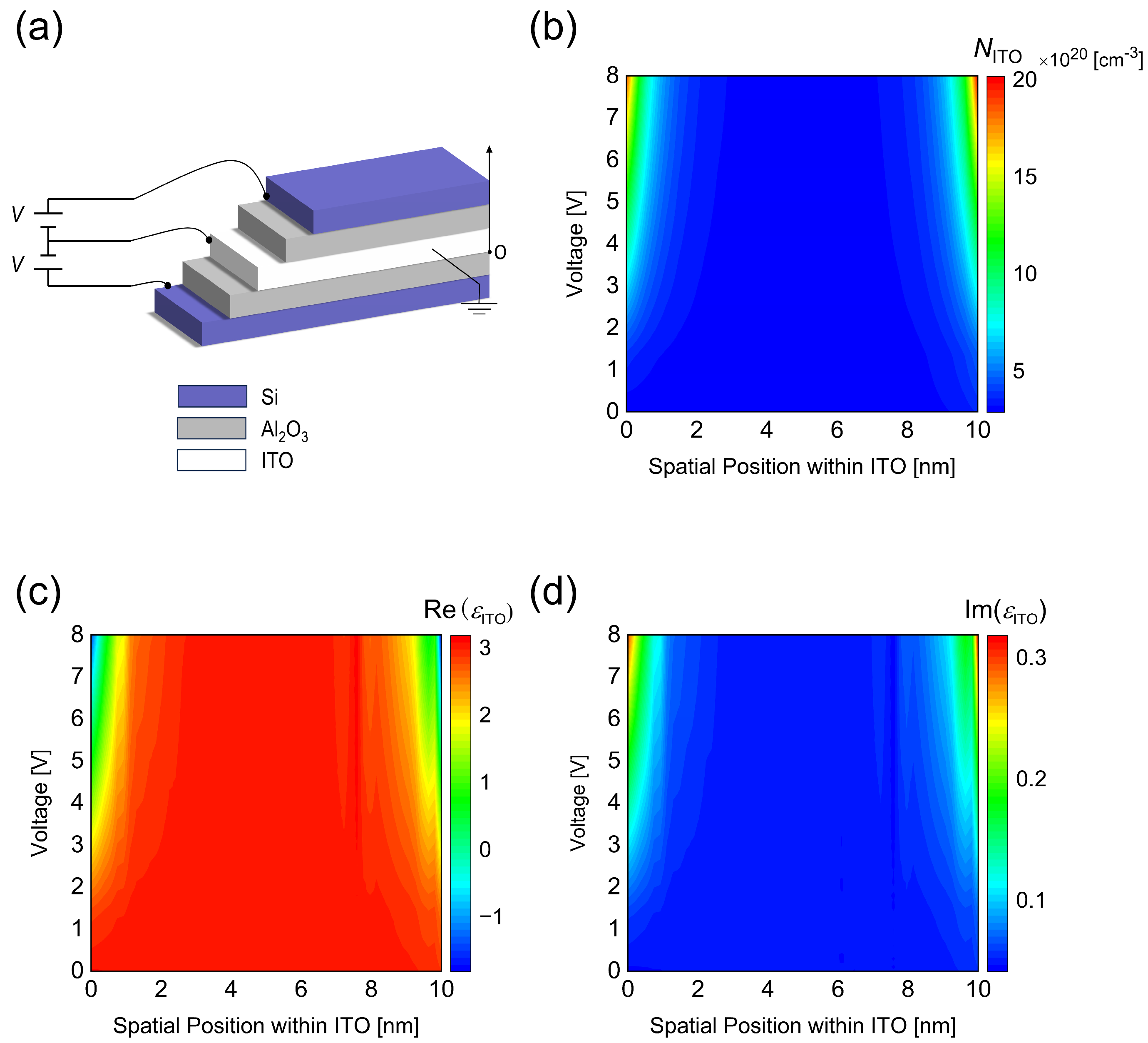
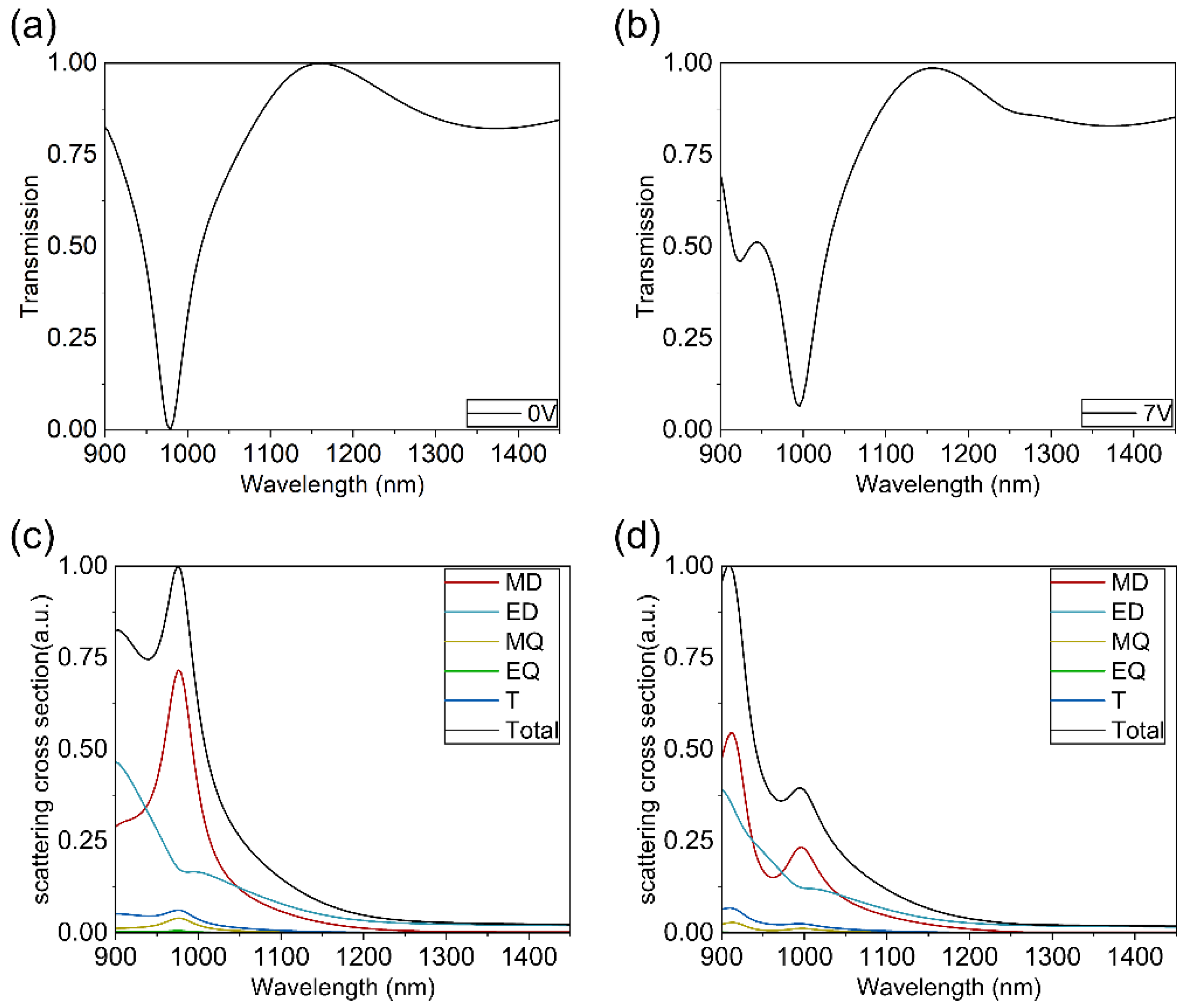
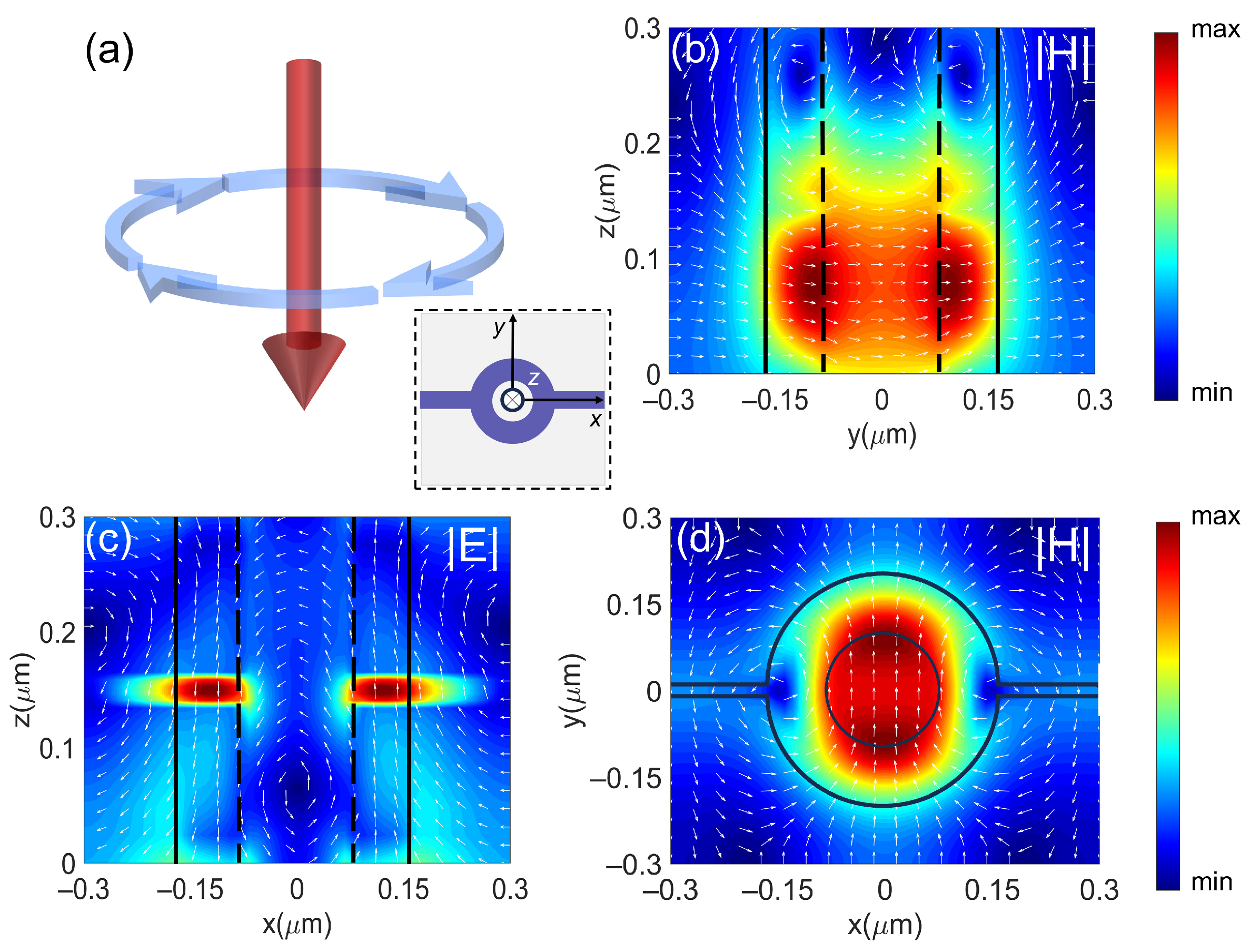
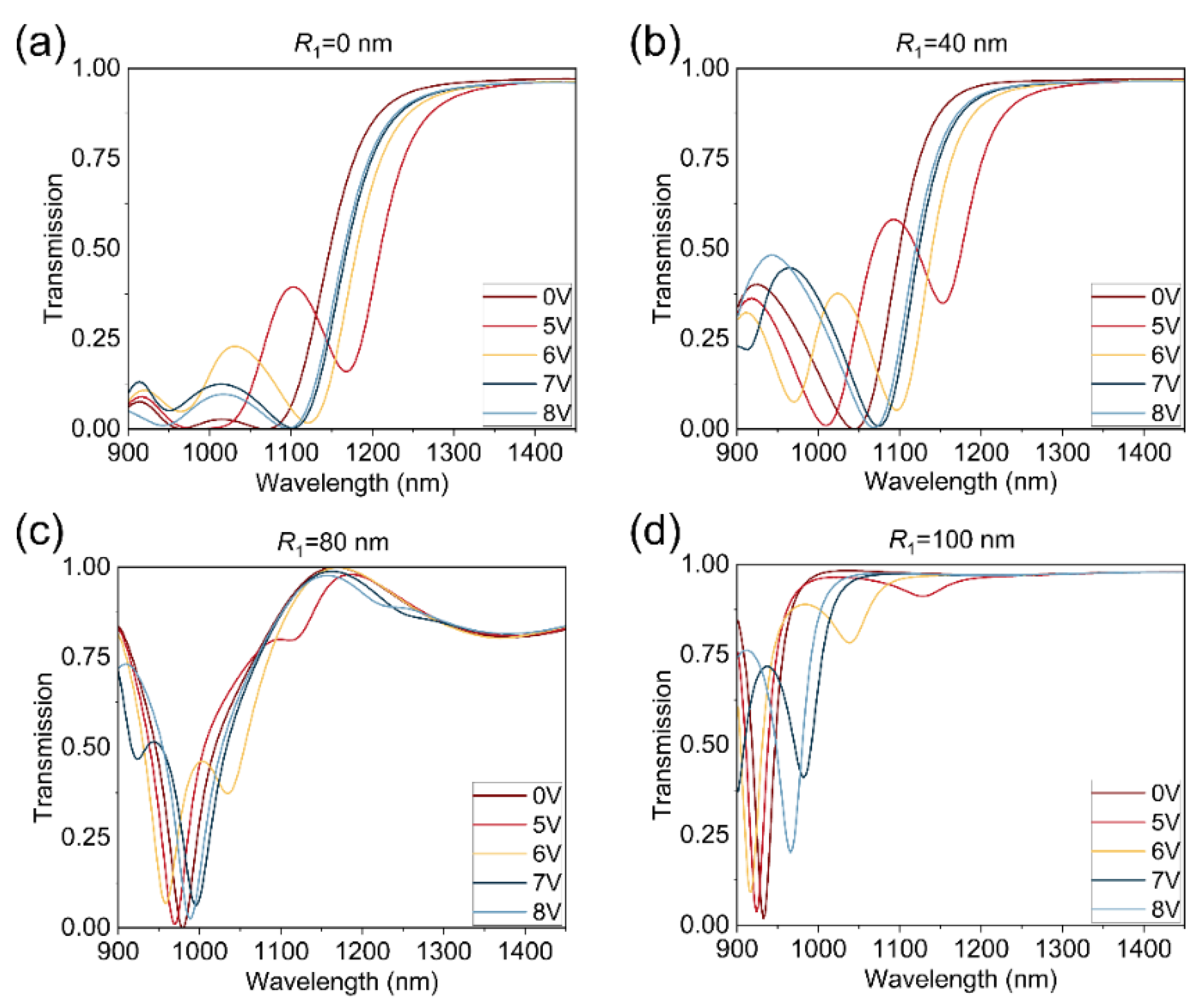
Disclaimer/Publisher’s Note: The statements, opinions and data contained in all publications are solely those of the individual author(s) and contributor(s) and not of MDPI and/or the editor(s). MDPI and/or the editor(s) disclaim responsibility for any injury to people or property resulting from any ideas, methods, instructions or products referred to in the content. |
© 2024 by the authors. Licensee MDPI, Basel, Switzerland. This article is an open access article distributed under the terms and conditions of the Creative Commons Attribution (CC BY) license (https://creativecommons.org/licenses/by/4.0/).
Share and Cite
Ma, R.; Mao, Y.; Li, P.; Li, D.; Wen, D. ITO-Based Electrically Tunable Metasurface for Active Control of Light Transmission. Nanomaterials 2024, 14, 1606. https://doi.org/10.3390/nano14191606
Ma R, Mao Y, Li P, Li D, Wen D. ITO-Based Electrically Tunable Metasurface for Active Control of Light Transmission. Nanomaterials. 2024; 14(19):1606. https://doi.org/10.3390/nano14191606
Chicago/Turabian StyleMa, Ruize, Yu Mao, Peiyang Li, Dong Li, and Dandan Wen. 2024. "ITO-Based Electrically Tunable Metasurface for Active Control of Light Transmission" Nanomaterials 14, no. 19: 1606. https://doi.org/10.3390/nano14191606





